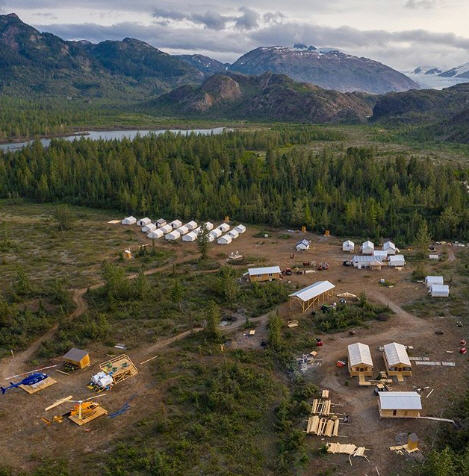
Last year’s maiden diamond drill program at the Burgundy Ridge area within Crystal Lake Mining’s 551-sq.-km Newmont Lake property in British Columbia’s Golden Triangle returned broad copper-gold-zinc-silver intercepts as well as high-grade gold mineralization.
Based on the drill results, the company sees potential for alkalic porphyry hypogene mineralization underneath Burgundy Ridge.
The diamond drill campaign tested the Green Rock, Ridge and Ridge West zones within the Burgundy Trend at Newmont Lake.
The company’s most recent press release includes both polymetallic intervals as well as its first high-grade gold intervals.
In 2018, Crystal Lake entered into an option agreement with Romios Gold Resources to earn a 100% interest in Newmont Lake
At Green Rock, hole BR19-16 returned 51.4 metres of 0.46% copper, 1.22% zinc, 0.17 g/t gold and 9.98 g/t silver as well as 0.16% lead starting at 343.7 metres and targeted the Green Rock breccia, which was discovered last year.
According to Crystal Lake, the multi-stage Green Rock breccia appears geologically similar to breccia units at alkalic porphyry-type deposits.
Drilling at the Ridge zone, 250 metres north of Green Rock, returned 184.7 metres of 0.21% copper, 0.14 g/t gold, 3.7 g/t silver and 0.17% zinc starting at surface in hole BR19-13.
This intercept includes higher-grade sulphide intervals, which are suspected offshoots of the Green Rock breccia. To date, skarn-style mineralization at Ridge has been traced over 600 metres of strike, which remains open both along strike and at depth.
Drillhole BR19-04 completed at the Ridge West area intersected 1.5 metres of 15.05 g/t gold and 4.03 g/t silver starting at 149 metres. According to the company, these are the first indications of a potential high-grade gold system adjacent to the porphyry target. Further downhole, Crystal Lake also hit additional suspected offshoots of the Green Rock breccia, reporting 2.6 metres of 3.64% copper and 32.32 g/t silver at 262.4 metres.
“Drilling from the maiden diamond drill program at Burgundy Ridge is shallow and minimal relative to the size of the property and the scale of the alkalic copper-gold porphyry deposits that we are modeling and targeting at Burgundy,” Cole Evans, the company’s CEO, said in a release.
“Strong surface and near-surface mineralization with alteration intersected thus far confirm the presence of well-mineralized alkalic porphyry systems along the 2.3-km Burgundy Trend. “
Evans added that future work at Newmont Lake will be focused on vectoring into the centres of this alkalic porphyry mineralization.
Nine of the ten holes drilled at the project last year hit mineralization, mostly in skarns. Hole BR19-04 intersected potassium feldspar alteration within a unit with strong biotite alteration, which graded up to 1.74 g/t gold, 5.04 g/t silver and 0.09% copper over 4.6 metres.
According to Crystal Lake, this intercept could potentially be the first hypogene interval form Burgundy Ridge as the alteration is not associated with a breccia.
Crystal Lake is also completing geological dating and mineral deposition dating work at the University of British Columbia’s research facility in Kelowna.
In 2018, Crystal Lake entered into an option agreement with Romios Gold Resources to earn a 100% interest in Newmont Lake. To do so, it must spend C$8 million on exploration at the project over a three-year period, pay Romios a total of C$2 million and issue the vendor 12 million of its shares.
In mid-June the company also announced that it intends to change its name to Enduro Metals.
Crystal Lake’s stock was down 4% on Monday on the TSXV. The company has a C$17.9 million market capitalization.
(A version of this article first appeared in the Canadian Mining Journal)